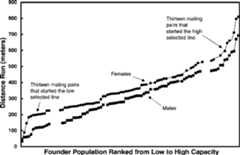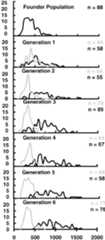DOI:10.1152/PHYSIOLGENOMICS.2001.5.1.45 - Corpus ID: 2340159
Artificial selection for intrinsic aerobic endurance running capacity in rats.
@article{Koch2001ArtificialSF, title={Artificial selection for intrinsic aerobic endurance running capacity in rats.}, author={Lauren Gerard Koch and Steven L. Britton}, journal={Physiological genomics}, year={2001}, volume={5 1}, pages={ 45-52 }, url={https://api.semanticscholar.org/CorpusID:2340159}}- L. KochS. Britton
- Published inPhysiological Genomics7 February 2001
- Biology
Artificial selection for intrinsic aerobic endurance running capacity was started using genetically heterogeneous N:NIH stock of rats as a founder population using a velocity-ramped running protocol and produced changes in body weight as a correlated trait.
405 Citations
Figures and Tables from this paper
405 Citations
Endurance capacity of mice selectively bred for high voluntary wheel running
The HR lines had significantly higher endurance than the C lines, whether or not body mass was used as a covariate in the analysis, reinforcing previous studies that indicate sex-specific responses to selective breeding.
Selection for aerobic capacity affects corticosterone, monoamines and wheel-running activity
- R. P. WatersK. RennerJ. Swallow
- 2008
Biology, Medicine
Continued artificial selection for running endurance in rats is associated with improved lung function.
- Scott D. KirktonR. A. HowlettP. Wagner
- 2009
Medicine, Biology
By generation 15, lung size in smaller HCR rats is not reduced in concert with their smaller body size, but has remained similar to that of LCR, supporting the hypothesis that continued selection for increased endurance capacity requires relatively larger lungs, supporting greater ventilation, gas exchange, and pulmonary vascular conductance.
Peripheral oxygen transport and utilization in rats following continued selective breeding for endurance running capacity.
- R. A. HowlettScott D. KirktonP. Wagner
- 2009
Biology, Medicine
The data suggest that many of the skeletal muscle structural and functional adaptations enabling greater O(2) utilization in HCR at G7 continue to progress following additional selective breeding for endurance capacity.
Selected contribution: Variation and heritability for the adaptational response to exercise in genetically heterogeneous rats.
- Michael Lee TroxellS. BrittonL. Koch
- 2003
Biology
Selectively bred models of both intrinsic (untrained) and adaptation response can be useful in resolving the genetic basis of variation in aerobic capacity.
Selectively bred rat model system for low and high response to exercise training.
- L. KochG. PollottS. Britton
- 2013
Biology, Medicine
Animal models developed from heterogeneous stock and enriched via selection, as presented here, often generate extreme values for traits of interest and may prove more useful than current models for uncovering genetic underpinnings.
Fuel Selection in Genetically Selected Endurance Running Rats at Submaximal Exercise Intensities
- K. Murphy
- 2007
Biology
The present results showed that the HCR's had a V02max and distance run to exhaustion that was 1.3 and 4.0 times greater than the LCR's respectively and both groups ofrats followed the pattern of fuel selection seen in previous studies where the same proportions of lipids and CHO are used at the same relative exercise intensity.
Maximum aerobic performance in lines of Mus selected for high wheel-running activity: effects of selection, oxygen availability and the mini-muscle phenotype
The results suggest that the physiological underpinnings of V̇O2max differ between the S and C lines, and apparently, at least in S lines, peripheral tissues may sustain higher rates of oxidative metabolism if central organs provide more O2.
Cardiac function in rats selectively bred for low- and high-capacity running.
- S. O. HussainJ. BarbatoL. KochP. J. MettingS. Britton
- 2001
Biology, Medicine
The results suggest that increased cardiac performance accounts for part of the difference in running capacity between the lines; and unlike exercise training, genetically determined intrinsic capacity for exercise does not influence the recovery from 25 min of global low-flow cardiac ischemia.
Phenotypic and evolutionary plasticity of body composition in rats selectively bred for high endurance capacity.
HCR rats fortify wheel running with increased food consumption along with greater hypertrophy of key organs for O2 transport, supporting the hypothesis that voluntary activity and physiological capacity are genetically correlated (self-induced adaptive plasticity).
...
35 References
Heritability of treadmill running endurance in rats.
Treadmill running was evaluated as a phenotype for selective breeding for high- and low-endurance performance from a starting population of 18 male and 24 female outbred Sprague-Dawley rats, implying that 39% of the variation in running endurance performance between the low and high selected lines was determined by heritable factors.
Artificial Selection for Increased Wheel-Running Behavior in House Mice
- J. SwallowP. CarterT. Garland
- 1998
Biology
Replicated within-family selection for increased voluntary wheel running in outbred house mice (Mus domesticus) was applied with four high-selected and four control lines (10 families/line) and resulted in an average 75% increase in activity in the four selected lines, as compared with control lines.
QUANTITATIVE GENETICS OF SPRINT RUNNING SPEED AND SWIMMING ENDURANCE IN LABORATORY HOUSE MICE (MUS DOMESTICUS)
- M. R. DohmJ. P. HayesT. Garland
- 1996
Biology
Evolution; international journal of organic…
It is predicted that artificial selection for increased locomotor speed in these mice would result in a decrease in endurance, but no change in body mass, which could lead to a better understanding of the physiological mechanisms leading to trade‐offs in aspects of locomotor abilities.
Modeling: optimal marathon performance on the basis of physiological factors.
- Michael J. Joyner
- 1991
Engineering
Analysis of marathon running times on the basis of various combinations of previously reported values of maximal O2 uptake, lactate threshold, and running economy in elite distance runners suggests that substantial improvements in marathon performance are "physiologically" possible or that current concepts regarding limiting factors in endurance running need additional refinement and empirical testing.
Influence of exercise intensity and duration on biochemical adaptations in skeletal muscle.
- G. DudleyW. AbrahamR. Terjung
- 1982
Biology, Medicine
Journal of applied physiology: respiratory…
The influence of intensity and daily duration of exercise on cytochrome c concentration in the three muscle fiber types was assessed in rats that were treadmill trained for 8 wk (5 days/wk) by 1 of…
Determination of metabolic and heart rate responses of rats to treadmill exercise.
A rapid-flow, open-circuit, indirect calorimeter was developed and used to study metabolic rates of rats at rest and in response to three running speeds and five grades and Electrocardiogram connections were available within the apparatus for simultaneous determination of heart rate.
Genomic scan for maximal oxygen uptake and its response to training in the HERITAGE Family Study.
- C. BouchardT. RankinenD. Rao
- 2000
Biology, Medicine
Results indicate that linkages at P values of 0.01 and better are observed with markers on 4q, 8q, 11p, and 14q for VO(2 max) before training and with markers for the change in VO( 2 max) in response to a 20-wk standardized endurance training program.
Familial aggregation of VO(2max) response to exercise training: results from the HERITAGE Family Study.
- C. BouchardP. AnD. Rao
- 1999
Medicine
The trainability of VO(2max) is highly familial and includes a significant genetic component, and the most parsimonious models yielded a maximal heritability estimate of 47%.
Cardiovascular response to treadmill exercise in untrained rats.
- T. GleesonK. Baldwin
- 1981
Medicine
Journal of applied physiology: respiratory…
The data suggest that HR, SV, and Cao2-Cvo2 make significant contributions to the augmentation of Vo2 in the exercising rat.
Time course adaptations in cardiac and skeletal muscle to different running programs.
- K. BaldwinD. A. CookeW. Cheadle
- 1977
Medicine
Journal of applied physiology: respiratory…
It is suggested that training programs incorporating elements of both "steady-state" incline and high-speed interval running can potentially induce respiratory enzyme adaptations in the greatest spectrum of rodent skeletal muscle fibers in addition to inducing adaptations to enhance contractile potential in cardiac muscle.
Related Papers
Showing 1 through 3 of 0 Related Papers








